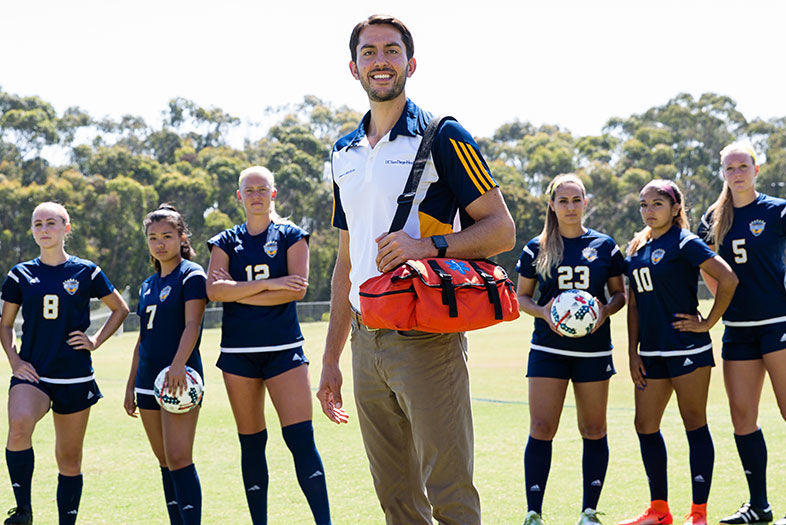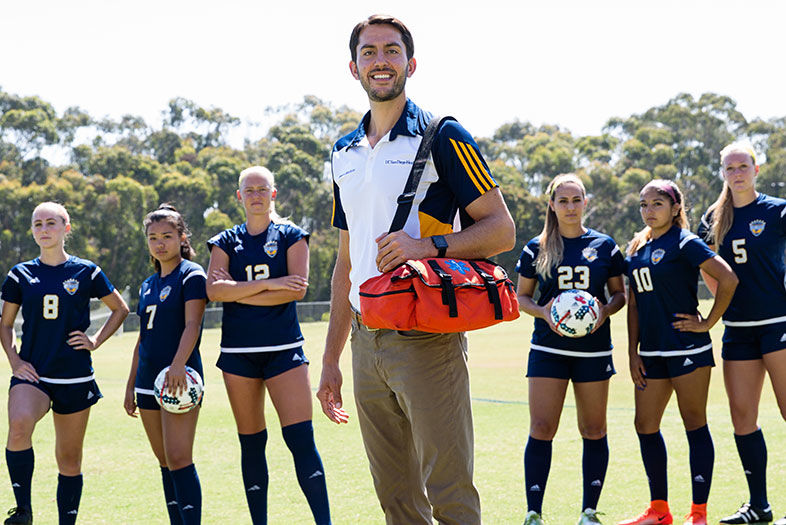We hope that our doctors practice what they preach. That they exercise, eat well, and meditate as much as they advise us to. If you see Dr. Alan Shahtaji, you can guarantee that he’s checking all those boxes—and then some.
On any given day, the UC San Diego Health family and sports medicine doctor can be found working out at Orangetheory Fitness, jogging in North County, downward dogging at CorePower Yoga, cycling on a stationary bike while reading up on patients at the Lawrence Family Jewish Community Center, or meditating with the Headspace app.
“Using exercise as medicine is pretty powerful,” says Shahtaji, 36. “I really like the primary care sports perspective, because you deal with your injuries and your musculoskeletal stuff, but you can also use exercise and sports for prevention and healing.”
Shahtaji’s affinity for sports started early. His father played for Iran’s professional soccer team and began coaching him during his upbringing in the Chicago suburbs. The younger Shahtaji had hopes of playing professionally, but after skipping a grade the self-proclaimed “late bloomer” continuously got injured and set his soccer goals aside.
He graduated from University of Illinois at Urbana-Champaign—switching from physical therapy to medicine, per his mother’s encouragement—and ended up at Midwestern University for medical school. It was there that he studied osteopathic medicine, which focuses on treating the person as one unit made of body, mind, and spirit. He still uses that mind-set today: “Doctors of osteopathy are trained to treat with our hands, and that’s helped me in sports medicine.”
During a family medicine residency at UC San Diego, he began assisting as a doctor for local high school and collegiate teams. Later, while completing a sports medicine fellowship at Wake Forest School of Medicine, he was not only serving all the university’s Division 1 teams, but also joined the medical staff for the U.S. Women’s National Soccer Team. Shahtaji is part of a pool of just a few doctors, ranging from primary care physicians to orthopedic surgeons, who travel with the celebrated team. It’s an unpaid position; he does it for the love of sport and travel. So far it’s taken him to Croatia, Slovenia, Cyprus, and Azerbaijan for the 2012 FIFA U-17 Women’s World Cup and its qualifying matches. And last year he was on hand for the USWNT during the Olympics in Brazil.
“I see parts of the world that I otherwise wouldn’t,” he says. “And there’s a great environment to provide care because you’re with them day in and day out. It’s really amazing because you go through the spectrum of things like a primary care clinic, and then there are the specific musculoskeletal injuries from playing.”
Shahtaji has treated upper respiratory infections, gastrointestinal illness, women’s health issues, concussions, and more.
Back in the States, he’s also a physician for the U.S. Soccer Federation’s youth teams, as well as the entirety of UC San Diego, from athletes to regular students. And he hasn’t hung up his own cleats yet. He plays on the US Medical Soccer Team, a league that brings together doctors from across the country. In addition to three long-weekend training sessions per year, this extracurricular also calls for international travel. This year’s World Medical Football Championships were hosted in Austria. “Especially in this day and age with so much conflict, it’s a tournament where we come together unified no matter what country you’re from,” he says. “It’s a great experience from that standpoint.”
Despite all this in-depth work with athletes, Shahtaji’s patient pool is a wide one.
“Just today I saw a 2-year-old and an 85-year-old at my primary care practice,” he says. “I do a sports concussion clinic, so that encapsulates a lot of different people—from somebody who fell and injured their shoulder to someone who’s having some palpitations when they run, and everything in between.”
The tricky part of his on-the-go gigs is finding time to actually be at one of his La Jolla clinics (or supervising medical residents at the San Ysidro Health Center). “Doing what I do and being so spread out, there’s so many opportunities for community involvement and helping my patients, but at the same time I have to ask myself, ‘Can I disconnect and practice what I preach?’ I think meditation helps remind me of that. It’s usually the first thing I do in the morning—after some coffee.”
He argues that multitasking may be behind some of patients’ most common somatic complaints, like headaches and stomach pain. “When you take a step back, we’re often trying to do multiple things at the same time. But through that mindfulness approach, a lot of those things can be alleviated with incorporation of nutrition, diet, and exercise. Those really take care of the majority of things we see in primary care. It’s an easy thing to talk about, but it’s a hard thing to do in terms of adjusting your whole lifestyle.”
But in our nearly perfect climate, there aren’t many excuses for not fitting in physical activity. “If I could give only one recommendation for prevention and health, it would be to stay active,” Shahtaji says. “Exercise is medicine, and that’s the great thing about San Diego—there’s always something active to do.”

UC San Diego Doctor Offers Skills at World Cup and Olympics
Photo by Jenny Siegwart


















